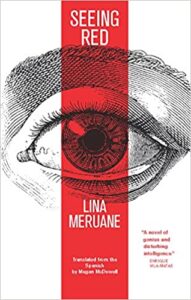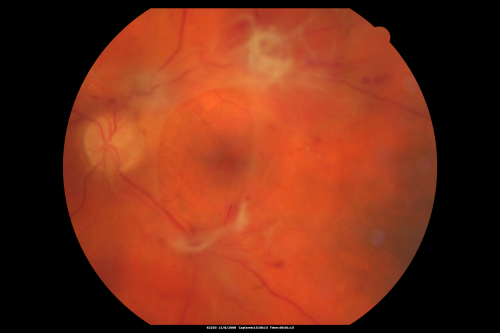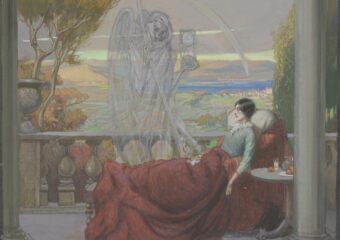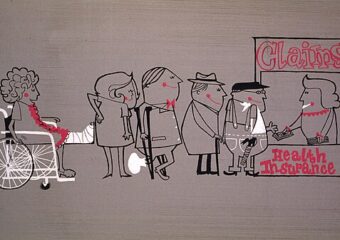Diabetes mellitus over the long term can wreak havoc on the body in the forms of coronary heart disease, nephropathy, peripheral arterial disease, and diffuse neuropathy. Some of the more frequent complications of diabetes involve the eyes with retinopathy being the greatest cause for concern. Diabetic retinopathy is the most common cause of blindness in people between twenty and seventy-five years of age in the U.S. A quarter to a third of people with diabetes have diabetic retinopathy. The condition can progress from mild forms to severe forms accompanied by exudates and microaneurysms, which in the worst-case progress to retinal hemorrhages irreversibly obliterating eyesight.
The novel, Seeing Red (I review here), follows the main character, Lina, from the time she experiences a catastrophic retinal hemorrhage through a series of treatments and recuperations. Lina is the first-person narrator and a type 1 diabetic. She is in her late twenties or early thirties when this happens, but she had known it was a likely possibility for many years.
They were brittle, those veins that sprouted from my retina and coiled and snaked through the transparent humor of my eye. To observe the growth of that winding vine of capillaries and conduits, to keep watch day by day over its millimetric expansion. That was the only thing that could be done: keep watch over the sinuous movement of the venous web advancing toward the center of my eye. That was all and it was a lot, the optician declared, just that, that’s it, he would repeat, averting his eyes, and looking at my clinical history that had grown into a mountain of papers, a thousand-page manuscript stuffed into a manila folder.
p. 5
Those veins eventually erupted, twice during the course of the novel, and Lina gives us an eyewitness account on both occasions. These accounts provide more vivid and terrorizing perspectives of what people experience with retinal hemorrhages than can be appreciated from classic biomedical descriptions. Biomedicine descriptions are from the outside in, whereas this literary description is from the inside out.
Below I compare a classic medical text description of a retinal hemorrhage from StatPearls with a literary description from the novel Seeing Red.
The Biomedical

From: Kanukollu VM, Ahmad SS. Retinal Hemorrhage. [Updated 2021 Aug 11]. In: StatPearls [Internet]. Treasure Island (FL): StatPearls Publishing; 2021 Jan.
Bleeding into the vitreous cavity is seen as fresh blood clots with sudden onset of floaters. Chronic hemorrhages appear as diffuse vitreous clouding with settled blood inferiorly. They are commonly seen due to the rupture of a vessel, as seen commonly in proliferative diabetic retinopathy, retinal arteriolar microaneurysm, or during posterior vitreous detachment. A subretinal hemorrhage can cause a breakthrough bleeding into the vitreous. Breakthrough hemorrhage into vitreous also happens in malignant choroidal melanoma, retinal vascular occlusions, and idiopathic polypoidal choroidal vasculopathy (IPCV).
The Literary

From: Seeing Red, Lina Meruane, (Megan McDowell, trans), Deep Vellum Publishing, Dallas, Tx, 2012.
The main character in this novel experiences two retinal hemorrhages. Here is how she describes the first occurrence:
And then a firecracker went off in my head. But no, it was no fire I was seeing, it was blood spilling out inside my eye. The most shockingly beautiful blood I have ever seen. The most outrageous. The most terrifying. The blood gushed, but only I could see it. With absolute clarity I watched as it thickened, I saw the pressure rise, I watched as I got dizzy, I saw my stomach turn, saw that I was starting to retch, and even so. I didn’t straighten up or move an inch, didn’t even try to breathe while I watched the show. Because that was the last thing I would see, that night, through that eye: a deep, black blood.
p. 4
The second occurrence follows a procedure Lina underwent to prevent any further bleeding episodes. The procedure came with no guarantees, indeed there was really only hope, and then it happened.
Blood, again, in my eye. A fine thread of blood that comes from I don’t know where. Another double effect, another copy of what happened before, it’s all happening again but this time I start to scream, to cry out and not from pain…I have my eyes wide open, I’m watching as the eye watches its thread of blood, looking at everything without creasing my cries: I’m bleeding I’m bleeding again…then I shout louder, I shout all the shouts I hadn’t shouted when I should have. I see red again, Ignacio [boyfriend], I’m seeing blood with my own eyes. (I want to yank out yours, stick them inside mine so you can see the blood.)
p. 142



